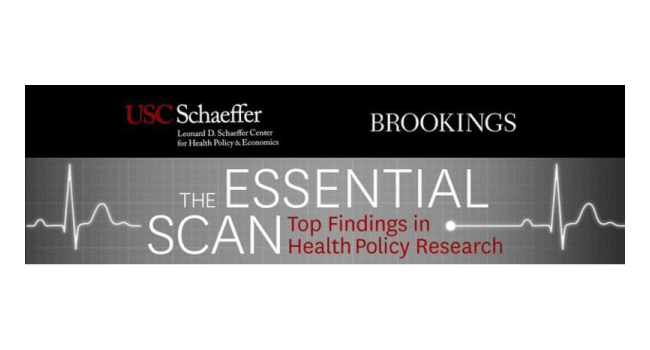What’s the latest in health policy research? The Essential Scan, produced by the Schaeffer Initiative for Health Policy, aims to help keep you informed on the latest research and what it means for policymakers. To sign up to receive the Essential Scan straight to your inbox, sign up here.
Mortality Declines with Increased Insurance Coverage
Study by: Jacob Goldin, Ithai Z. Lurie, and Janet McCubbin
Under the ACA’s individual mandate, taxpayers who did not have insurance in the previous year were subject to a tax penalty, administered by the IRS. In 2017, the IRS sent informational letters to a random group of households who had paid the tax penalty, informing them of their health insurance options under the law. A new paper uses this pilot program’s randomized design to study the effect of the letter on health insurance take-up, finding that among individuals who were uninsured during the prior year, those who received the letters were 1.3 percentage points more likely to enroll in coverage the next year. They also found that in the two years following the intervention, the rate of mortality among 45 to 64 year olds who were previously uninsured who received the letter was lower, providing the first experimental evidence that health insurance reduces mortality. Although the tax penalty associated with the individual mandate has been repealed on the federal level, this information may be beneficial for state governments considering imposing mandates. Full study here.
Combining Life and Health Insurance to Improve Access to Expensive, Life-Saving Drugs
Study by: Ralph S.J. Koijen and Stijn Van Nieuwerburgh
Advances in medicine and drug development have produced new treatments that result in life-saving or life-extending treatments for patients with many different diseases. However, these treatments are expensive. Life insurance companies, who benefit from innovative drugs that significantly extend life, may provide a new avenue for improving access to these drugs. A new study estimates that the life insurance sector’s aggregate benefit from immunotherapy treatments is $9.8 billion per year. The researchers argue this added value may help finance the cost of cancer care for patients with life insurance. The paper discusses the basic economics of integrating health and life insurers and potential frictions that may slow such integration, as well as broader implications for the pharmaceutical industry, and drug innovation. As advances in medicine continue to expand and improve outcomes for patients, this paper offers a potential path to improve access to those life-saving treatments. Full study here.
“This paper demonstrates that there are other actors in the insurance industry that should have a vested interest in making sure patients get effective treatment. The challenge for U.S. policymakers is how to better engage them.”
Dana Goldman
Director, USC Schaeffer Center
The Proportion of Adult Americans with Primary Care Decreased Between 2002 and 2015
Study by: David M. Levine, Jeffrey A. Linder, and Bruce E. Landon
Receiving primary care is associated with a number of health benefits, including improved mortality. A new study analyzed nationally representative data from 2002 through 2015 to understand trends in who is receiving primary care in the U.S. The authors found the proportion of all adult Americans with an identified source of primary care decreased slightly, from 77 to 75 percent, during this time frame. Adults who were younger, less medically complex, of a minority background, or living in the South were associated with a significant decrease in the likelihood of having an identified primary care source. For example, 71 percent of adults in their 30s had primary care in 2002 compared with 64 percent in 2015. An exception was adults with three or more chronic conditions, whose proportion with a primary care doctor remained stable. The authors point to valuing convenience over continuity of care (especially for younger people), financial barriers, and shortages in primary care providers as possible explanations for this finding. Full study here.
Addressing Out-of-Network Billing Could Save $40 Billion Annually
Study by: Zack Cooper, Hao Nguyen, Nathan Shekita, and Fiona Scott Morton
To better understand the broader economic impact of out-of-network billing, a new study leverages data from 2015 provided by a large commercial insurer to estimate how often out-of-network billing occurs at in-network hospitals and the impact on negotiated payments. The researchers found that at in-network hospitals, 5 to 12 percent of cases analyzed, depending on the specialty, were billed out-of-network. The authors argue that the ability to bill out of network allows these specialists to negotiate artificially high in-network rates, compared to other types of providers. They found in-network rates were 367 percent of Medicare rates for anesthesiologists, 343 percent for pathologists, 195 percent for radiologists, and 176 percent for assistant surgeons. According to their analysis, out-of-network billing was concentrated in a minority of hospitals. Hospitals in more concentrated markets and those that were for-profit were more likely to have out-of-network providers. The researchers estimate that if these four types of specialists were not able to bill out of network, it would lower physician payments for privately insured patients by 13.4 percent and reduce healthcare spending for people with employer-sponsored insurance by 3.4 percent (approximately $40 billion annually). They propose requiring hospitals to sell a package of facility and physician services, arguing it would protect patients, restore a competitively determined price for physician services, and lower commercial health spending. Full study here.
Click here to receive The Essential Scan email.
The Essential Scan is produced by the USC-Brookings Schaeffer Initiative for Health Policy, a collaboration between the Brookings Institution and the USC Schaeffer Center for Health Policy & Economics.
